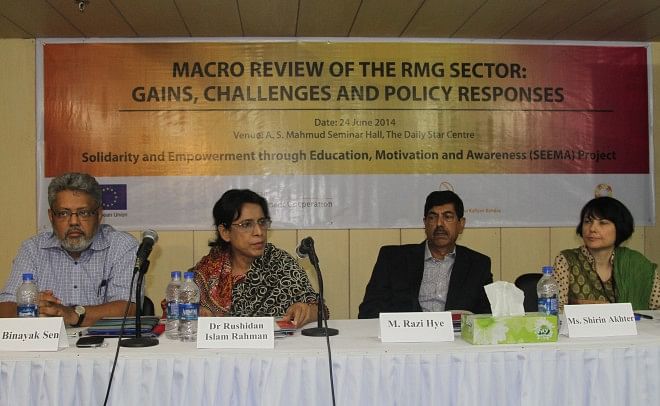Macro Review of the RMG Sector: Gains, Challenges and Policy Responses


It is time to reflect on the industry, time to acknowledge the contributions of all those who are involved, particularly the women, whose contributions often go unacknowledged and unregistered. It is time for all of us to collectively think about our parts in the continued improvement. We are all very deeply shocked with the Rana Plaza tragedy and that called many actions on behalf of the industry, on the part of the government and part of the civil society. Huge gains have been made and it is definitely time to celebrate those gains. Care, for example, has agreed to be part of the Bangladesh Alliance for Workers safety, and we have decided add our voice to the efforts to improve safety standards and working conditions for the women and men in the industry. In addition, government, BGMEA and ILO have all engaged in different efforts in the accord. It is really time to coordinate these efforts, to collaborate and to move together to increase the competitiveness of the sector in relation to other countries, to improve the sustainability of the sector and also the sustainability of the livelihoods of the workers.

Shirin Akhter, Honorable Member of Parliament
Made in Bangladesh is a brand recognized all over the world. But the workers who are contributing to take the industry to an upper level, most of whom are women, are yet to be recognized.
In the beginning there was no fixed wage for workers in this industry but at some point the minimum wage was set to Tk 930 per month. After that, the minimum wage was increased to Tk 1200, then Tk 1662, then 3000Tk and at present 5300 Tk. This industry has gone through long periods of struggle.
Workers can be protected if the industry is protected and vice versa. Thus, we need to ensure safety and fair wages of garments workers but we cannot place all the responsibilities on garments owners alone. We need to also include international buyers and organizations. We firmly believe that if we can continue with the development of this industry in a united and coordinated way then Bangladesh will surely progress further.

Zillul Hye Razi, Trade Advisor, European Union
The European Union had significant contributions in the garments industry of Bangladesh. There was a quota free access for Bangladesh during the period of Micro Financial Assistance to non-European Union countries. Competitive garments industries of other countries like China, Thailand, Pakistan, all had quota restrictions on them. The exports of garments from Bangladesh found phenomenally growth in European Union countries at that time.
Between 2010 and 2013, the growth was about 57 percent. Last year, garment exports to the EU stood at around 10 billion euros—about 91 percent of overall exports to the region. At this time, Bangladesh stands at number two after China in garments exports in European Union. We have been able to create a strong position for ourselves as global garments exporters and we need to retain this position.
From January 2014, a new cycle started in GSP plus, which was for vulnerable developing country. These countries get duty free access in European Union countries if they ratify global conventions. We need to ensure that Bangladesh retains this GSP plus, as there could be a temporary suspension of GSP privileges in the space of all or certain products if there are systematic violation of certain UN or ILO conventions.

Fatima Jahan Seema, Team Leader- SEEMA Project, CARE Bangladesh
More than two decades CARE Bangladesh has been working with RMG sector. As we all know that the advent of the RMG industry created job opportunities for semi skilled and unskilled labor particularly for females who previously were employed by the informal sector or engaged in household work. Recent McKinsey (2011) report highlighted Bangladesh as the next 'sourcing hotspot'. Whilst Bangladesh is known for production of lower to medium value garments, increasingly the local industry is expanding into higher-end products and value-added services which require increased skill and capacity in the workforce both at the level of production line workers and middle management.
Since 2011 CARE Bangladesh has been implementing SEEMA project to promote and protect the rights of female garments worker. It mostly focuses on establishing linkage with different service providers, consultation with factory management, functional literacy and awareness building. We have been implementing session to build awareness among female garment workers. We have also imparting education that has led to a new consciousness, responsibility, self worth, societal and gender analysis and access to skills and information. The economic empowerment approach has relied on improving women's control over economic resources, decision making and strengthening women's economic security.
The SEEMA project undertook a macro policy review and a study applying rigorous methodology to understand the challenges, opportunities and finding out ways to increase capability of the workforce both at micro and macro level. The objective of the round table discussion is to share the findings and foster dialogues between different stakeholders like buyers, government authorities, academia, representatives of different worker categories to facilitate negotiations, information dissemination and working out sustainable solutions for improving the living and working condition of the workers that will ultimately contribute to the sector.

Dr Binayak Sen, Research Director, BIDS and Keynote Presenter of the session
My presentation will focus on economic sociology of readymade garments sector and policy implications emerging from there.
Acceleration of national growth and structural transformation was not possible without the RMG sector. RMG sector growth has poverty reducing effects and has positive externalities at household and community levels. Compliant factories are better in protecting these gains to the workers and their communities compared to the non-compliant factories. RMG sector faces considerable challenges by way of compliance requirements. It is possible to respond effectively to these challenges by designing innovative policies.
There are three major drivers of economic growth: agriculture, exports, remittance from abroad. Export's share of GDP increased from 7% in the late 1970s to over 20% in the 2010s. RMG represents over 70% of total export earnings. Knit garments are presently exported to over 148 countries and woven products to over 132 countries. It is also the prime sector behind the structural transformation of the economy. Industry's share of GDP has increased from 20% in the early 1990s to over 30% in the 2010s with concomitant drop in the share of agriculture from about 30 to 18% during the same period.
The BGMEA claims about two-third of manufacturing employment are in the RMG sector. There is, however, controversy regarding the size of RMG employment. Factory inspection data points out 2.2 million workers as opposed to BGMEA-reported over 4 million workers. This shows the importance of setting up an independent survey instrument for the RMG sector by BBS, BIDS and other disinterested parties.
Cost-sharing is needed among various actors which includes global market actors, domestic private sector, state, NGOs and workers. The RMG workers consumptions clearly shows that they spend much higher proportion on toiletries and other items compared to average urban workers in HIS. This is directly related to some of those corporate units that produce domestic toiletries. Incidentally, the domestic corporate workers should think beyond nominal corporate social responsibilities which they are presently doing. They should think in a focused way to mitigate the challenges faced by the workers. They could take some part of the health cost or secondary schooling costs of the workers' children.
Globally speaking, there are two innovative ways of cost sharing. One is that, the US market earns tariff revenue from our exports of about $850 million to $900 million every year. That money, which is earned and retained by the US government can be planned to finance and fund the compliance requirement in Bangladesh. Another proposal was mentioned by Professor Yunus around one year ago when the Rana Plaza tragedy took place. He cited the example of fair trade where if you want to buy a coffee, you pay a little higher price for that coffee. Similarly, if an American buyer pays extra 50 cents for a shirt, the extra amount could go for the compliance fund. This is directly linking the sensitivity of global buyers and their citizens to support compliance costs. Good compliance costs could be very high but good enough compliance costs can be within considerable limit. In order to implement full compliance, excluding building relocation costs, the cost would be around Tk 35 lakhs. We should discuss the compliance issues much more seriously with adequate data on compliance.

Khandokar Mostan Hossain, Joint Secretary (Labour), Ministry of Labour and Employment
There were around 1000 recommendations to amend the Labour Law 2006 and after consulting with ILO and other organizations, the law was amended last year. The amendment of the trade union regulation and subsequent formation of a good number of trade unions are big improvements.
We have several policies but there is a lack of implementation. Compared to the growth of the garments industry, the inspection department responsible for checking inaccuracies in factories did not have adequate manpower or logistics support. The inspection department has since been developed to accommodate 913 staff members instead of 314.
Since April last year, a total of 1,590 garment factories have been inspected by three agencies-Accord, Alliance and Buet. They found only 14-15 faulty garments. Steps have been taken to improve the assessment procedure. BIDS has recently published a report that the risk factor is not that much. However, we can in no way allow a second disaster like Rana Plaza to take place.

Ayesha Khanam, President, Bangladesh Mahila Parisad
I am a bit sceptic about the concept of 'good enough' compliance suggested by Binayak Sen. When we talk to women workers of the RMG sector, they still complain about issues like sexual harassment, fair wages, job permanence etc. There are serious problems regarding questions of their housing, health, transportation, and working conditions, and these problems need to be addressed.
The bargaining capacity of women workers is very poor. Trade unions do not seem to be efficiently dealing with issues regarding the safety and security of women workers. The women's movement is seriously looking at how effective and positive changes can be made in the lives of women garment workers through policy changes and discussions with development partners and the trade union. I would also like to request economists to include gender dimensions, apart from just budget analysis, when talking about improving the RMG sector.

Professor MM Akash, Department of Economics, University of Dhaka
We need to look at this issue from a local point of view. We need to identify our own lacking and work on that.
Physical compliance requires fire exit ways, implementation of wide staircases, and the final part is the relocation of the factory. Tk 3000 crore will be needed for minimum security in around 1000 garments factories. The owners of garments factories are very organised. After the Rana Plaza incident, they started lobbying in an organised manner, stating that they would have to go through several hardships to be fully compliant and thus would need some benefits to ensure that compliance. The government agreed to deduct source tax on garment exports for the next two years from 0.8 percent to 0.3 percent. So now they get to save 50 cents for every $100 with the condition that they will ensure physical security. So if garments worth $20 billion are exported every year, then they easily get Tk 4000 crore through what they save from the tax cuts. They can thus easily pay the compliance costs as they had taken this advantage after promising to deliver full compliance.
Garment manufacturers had badly exploited their workers all these years. Now they have to opt for limited exploitation and for that they have to apply a major part of their earned surplus for upgrading. And this will not be limited to just compliance but education, technology and productivity, among other things.

Dr Khondaker Golam Moazzem , Additional Research Director, Centre for Policy Dialogue (CPD)
We need to see whether the government is actually giving the same kind of policy support to the garments sector as it did in the 1980s or 90s. Today's garments sector is not the same as what the sector was three decades ago. There have been several changes. These changes need to be addressed and amendments need to be made to existing policies.
The garments industry is yet to accept and work according to the rules and regulations set by the government and to talk about 'good enough' compliance in this environment would mean that the factories are asked to opt for something below the set rules and regulations. We don't have the space to go below the set rules for compliance as there are already many flexibilities existing within the compliance rules set by the government.
There are two types of costs that should be regarded when talking about compliance costs, the first being fixed costs and the other being variable costs. If we place these two costs under the operation costs of factories, it will not be a huge sum. If we talk about relocation costs of non-compliant factories, we need to consider that the depreciation costs of these factories should already be accounted for. Considering the profit structures set by these factories, they earn their returns in several layers. Thus, even if we talk about relocation costs, this should be accounted within the existing costs of the factories.

Zafrul Hasan, Joint Secretary General, Bangladesh Institute of Labour Studies (BILS)
I would like to stress on the sad condition of trade unions in the country. There were five garments factories in Rana Plaza but none of these factories had a trade union. Even if one of these factories had an effective trade union then the police could not force workers to go to work even after cracks were seen on the building.
The government is giving several incentives to factory owners. Through the Right to Information Act, workers should be made aware of the amount of benefits that factory owners are currently getting from the government.

Dr Nazneen Ahmed, Senior Research Fellow, BIDS
We need to maintain a database to accurately know how many workers are actually working in the RMG workforce.
We definitely need accountability for compliance costs to understand how much is actually being spent to ensure that they follow the rules and regulations. But if we are too strict about that then compliance tends to be seen by factory owners as a forced responsibility. We need to create awareness amongst owners to ensure them that they will benefit if they maintain compliance. An environment is needed to ensure productivity and thus having a building that gives the workers a safe, hygienic environment, a clean washroom or ensuring that workers get their due wages and rights will ultimately help productivity.
There are many quality factories in the countries. Workers of these factories have asserted that they are extremely happy with their working environment and this sense of contentment is not dependent on the continuance of this programme. We need to highlight these factories as examples to show other factory owners, and encourage them to ask themselves how they are being able to get big orders despite being fully compliant.

Abul Hossain, President, Textile Garment Workers Federation
In Bangladesh, our commerce minister usually leads the discussion on issues related to RMG sector. But RMG is very much involved with the industry ministry and labour ministry. I do not know why they do not take the lead in the RMG issue where the interests of industry and labours are at stake.

Dr. Rushidan Islam Rahman, Research Director, BIDS
Workers, who retire at the age of 32 or 35 years after working for 15 to 20 years, do not quit their jobs voluntarily. They do this because their efficiency falls, they are tired of doing this job and employers do not want to retain these workers after they hit 35 years. I have a specific proposal to address this issue. Special schemes can be adopted for RMG workers who are forced to quit at such a young age. It could be in the form of pension, as a small portion of their wages could be cut to accord for their savings as pension. The government and

 For all latest news, follow The Daily Star's Google News channel.
For all latest news, follow The Daily Star's Google News channel. 



Comments